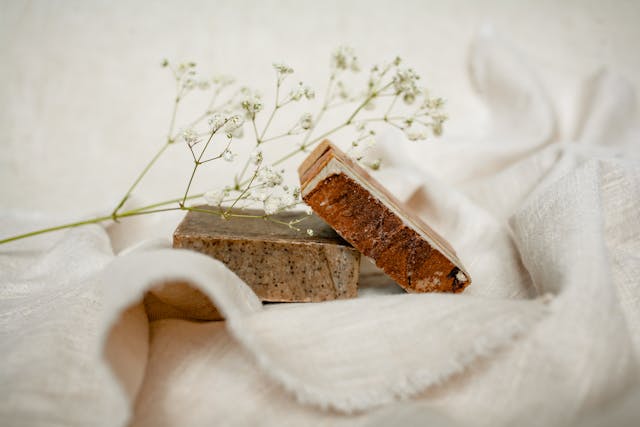Solid shampoos are becoming more and more popular, and many stores are stocking them. But if you're on this more ecological and skin-friendly path, perhaps you'd like to be able to make your own solid shampoo?
If so, this article is for you.
Why a solid shampoo?
The primary purpose of a shampoo is to cleanse the hair and scalp, but most "classic" shampoos contain numerous allergenic and irritating ingredients, and natural shampoos, although healthier, are no less polluting because of their packaging.
Solid shampoos offer many advantages. Firstly, they are made fromnatural ingredients, without sulfates, parabens or silicones, making them healthier. What's more, they don't require the use of conditioner. They are also more effective than industrial silicone shampoos, actually nourishing the hair rather than coating it.
Like liquid shampoos, solid shampoos can be adapted to suit your hair type. They're also inexpensive and last longer than other shampoos. And last but not least, they're quick and easy to make yourself.
Solid shampoo: focus on natural ingredients!
If you'd like to make your own solid shampoo, it couldn't be easier: all you need to do is find the right ingredients for your hair type. Although some of them need to be ordered over the internet, most are fairly easy to find in organic stores. Try to choose organic, biodegradable, eco-friendly and natural products.
The first ingredient you'll need is a surfactant to solidify the shampoo. It also cleans and lathers. It's the only chemical ingredient in the recipe, and although often criticized, it's indispensable. However, make sure that it does not exceed 60% of the recipe.
However, to avoid sulfates, it's advisable to opt for gentler surfactants like Sodium Cocoyl Isethionate (SCI), a derivative of coconut oil. It comes in powder form, is non-irritating to the scalp and is environmentally friendly. Avoid SLS (Sodium Lauryl Sulfate), which is irritating, or SLES (Sodium Laureth Sulfate), which is not only irritating but also potentially carcinogenic.

The second ingredient you'll need is a mineral or vegetable powder. You can choose it according to your hair type. For oily hair, opt for clay, burdock or rhassoul powder. For damaged hair or dandruff, you can use nettle powder.
Shikakai, an Ayurvedic powder, is useful for promoting hair growth and for dark hair. If your hair is difficult to detangle, you can use marshmallow powder. To keep your hair soft and supple, use orange powder. Sidr powder is useful for blond hair, itching or dandruff.
Always ensure that vegetable powders account for 10% of your product.
Vegetable oils or butters make up 20-25% of your recipe. These protect and repair your hair and scalp, and add shine. As with mineral or vegetable powders, oils and butters can be adapted to each specific need. For dry hair, opt forcoconut oilvery nourishing, or sweet almond oil. shea butter or argan oil.
If your hair tends to oil up quickly, opt for jojoba oil, and if it's damaged, use borage or castor oil to optimize repair. Broccoli oil is useful for curly hair, and avocado and castor oil for damaged hair. ricin to combat hair loss. Chaulmoogra oil is used to eliminate dandruff.
Essential oils are used for their virtues, but they are not essential to the recipe. If you wish, add 20 drops to your shampoo. Here are a few examples:
- Dull, brittle hair: rosewood, lemon, geranium or noble laurel.
- Dry hair : ylang-ylang or sweet orange.
- Oily hair: tea-tree, geranium, lavender or palmarossa.
Be careful, however, as essential oils are highly concentrated and should be handled with care. They should not be used by pregnant or breast-feeding women, or by children under 6 years of age.
Water or floral water (hydrolate), dissolves the surfactant, which is insoluble in oil. If you'd like to add extra benefits to your shampoo, use 15% floral water in the preparation.
Home recipe for solid shampoo
- A silicone mould in the shape of your choice.
- 60 g SCI surfactant.
- 10 ml water.
- 20 g vegetable oil or butter.
- 10 g mineral or vegetable powder.
- 20 drops of essential oil.
- Melt the surfactant with the water and coconut oil in a bain-marie, stirring constantly with a spatula.
- Add the clay powder.
- Remove from the heat and add the essential oils.
- Pack tightly into a mould and leave to harden for 24 hours.
- SCI surfactant is fairly volatile, so wear a mask as a precaution, and make sure the room you're in is well-ventilated.
How to use solid shampoo
Work the solid shampoo into a lather between your hands and apply to wet hair. The most important thing is to work the lather into the scalp. The ends of the hair will receive the shampoo through your hand movements. If you prefer, you can rub the shampoo directly into your hair. Rinse well.
Avoid washing your hair too regularly, as this can lead to rapid greasing.
To keep your shampoo in the best possible condition, remember to dry it on a wooden soap dish or dry washcloth.
It's up to you! With solid shampoos, not only are you protecting your skin from toxic agents, you're also protecting the planet. So why wait?



